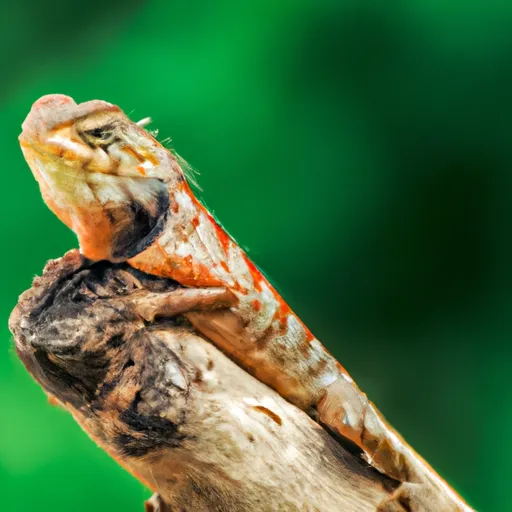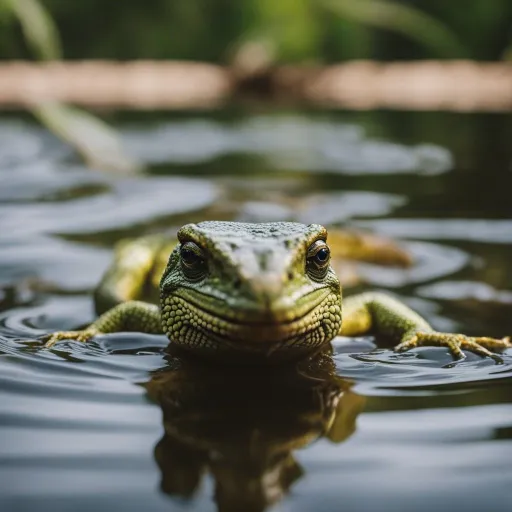So, you’ve come across a small lizard and you can’t help but wonder, do these tiny creatures have the capability to bite?
Well, the short answer is yes, small lizards do bite. While they may not pose a serious threat like their larger counterparts, it’s important to understand that a bite from a small lizard can still result in some discomfort.
In this article, we will explore why small lizards bite, the potential risks associated with their bites, and some simple precautions you can take to avoid getting nipped by these curious critters.

Do Small Lizards Bite
If you’ve ever encountered small lizards, you may have wondered whether or not they bite. Understanding lizard behavior is key to answering this question.
So let’s dive into the captivating world of small lizards and uncover the truth behind their biting tendencies.
Understanding Lizard Behavior
To understand whether small lizards bite, it’s essential to delve into their behavior. Lizards, like any other animals, exhibit instinctual behavior that is influenced by various factors. They communicate through body language and adapt their behavior according to their environment and social interactions.
Lizard body language can be fascinating to observe. They use various gestures and postures to communicate their intentions and emotions. Paying attention to their movements, such as head-bobbing, tail flicking, and changes in skin color, can give you valuable insights into their behavioral patterns.
While some lizards may display aggression towards other lizards, it is important to understand the difference between aggressive and territorial behavior. Aggressive behavior is typically directed towards members of their own species or even towards other animals, while territorial behavior is aimed at defending their territory from intruders, including humans.
Feeding and hunting patterns also influence lizard behavior. Small lizards are mostly insectivores and have specific feeding habits. Understanding their natural tendencies can provide valuable information about their behavior and whether they are likely to bite.
Classification of Lizards
Before we delve into the biting tendencies of small lizards, let’s first explore the classification of these intriguing creatures. Lizards belong to the reptile family and are classified into various groups based on their evolutionary traits and characteristics.
Reptiles, including lizards, belong to the class Reptilia. Within this class, lizards are further classified into several families, each with distinct features and behaviors. Some of the common families of small lizards include Gekkonidae (geckos), Polychrotidae (anoles), Scincidae (skinks), and Chamaeleonidae (chameleons).
Understanding the classification of lizards can help us appreciate the diversity of small lizards and further understand their behavior and tendencies.
Types of Small Lizards
Now that we have a basic understanding of lizard classification, let’s explore some of the different types of small lizards you may encounter. Here are a few examples:
Geckos
Geckos are among the most well-known and commonly encountered small lizards. They are famous for their ability to climb walls and ceilings due to specialized toe pads. Geckos are generally harmless and do not pose a significant biting risk to humans.
Anoles
Anoles are another type of small lizard that are often found in tropical and subtropical regions. They are known for their vibrant color-changing ability. Anoles may bite if they feel threatened or cornered, but their bites are usually non-venomous and not dangerous.
Skinks
Skinks are small lizards with smooth, shiny scales and slender bodies. They are commonly found in various habitats around the world. While some skinks may bite if provoked, their bites are typically harmless and more of a defense mechanism than an aggressive behavior.
Chameleons
Chameleons are fascinating creatures known for their ability to change color. They are primarily arboreal and have a unique body shape and long, extendable tongue for hunting insects. Chameleons seldom bite humans unless they perceive a threat, such as improper handling.
It is important to note that the biting tendencies of small lizards can vary even within the same species, so it’s essential to approach each encounter with caution and respect.

Factors That Influence Lizard Behavior
Several factors play a role in shaping the behavior of small lizards. Understanding these factors can provide insight into their likelihood of biting. Let’s take a closer look at some of the key influences on lizard behavior.
Environmental Factors
The environment in which a lizard lives greatly affects its behavior. Factors such as temperature, humidity, and availability of food and water can impact their activity levels and overall temperament. Lizards may become more defensive if their habitat is disrupted or if they feel exposed and vulnerable.
Territoriality and Mating Season
Lizards, like many other animals, can display territorial behavior. During mating season, males often become more aggressive and territorial to defend their breeding grounds and attract mates. It is crucial to be mindful of these behaviors during certain times of the year when encountering small lizards.
Predator-Prey Relationships
Lizards have evolved various defense mechanisms to protect themselves from predators. They may exhibit defensive behaviors such as biting, tail lashing, or puffing up their bodies to appear larger. Understanding these natural responses can help prevent negative interactions with small lizards.
Habitat and Diet
The specific habitat and diet of small lizards can influence their behavior. Some lizard species may be more prone to biting due to limited resources or competition for food and territory. It is important to respect their natural habitats and provide adequate hiding spots to help minimize potential conflicts.
Lizards with Biting Tendencies
While many small lizards are generally harmless and prefer to avoid human contact, there are some species that are known for their biting tendencies. Let’s take a closer look at a few examples:
Aggressive Species
Certain species, such as monitor lizards, can be more aggressive in nature. Monitor lizards have strong jaws and sharp teeth, making their bites potentially more harmful. While they are not commonly encountered as small lizards, it is essential to exercise caution if you come across one.
Venomous Lizards
Venomous lizards, such as the Gila monster and the Mexican beaded lizard, have evolved venom glands. Their bites can be dangerous and potentially life-threatening. However, it is important to note that venomous lizards are relatively rare, and the chances of encountering one are low, especially when it comes to small lizards.
Defensive Biting
In some cases, small lizards may resort to biting as a defense mechanism. They may bite if they feel threatened or cornered. It is crucial to handle small lizards with care and practice proper techniques to avoid triggering defensive biting behavior.
Reasons Why Lizards Bite
Understanding the reasons behind lizard bites can help us mitigate potential risks and avoid unnecessary encounters. Here are some common reasons why small lizards may bite:
Territorial Defense
Lizards are known to fiercely defend their territory. If you invade their space or approach too closely, especially during their mating season, they may perceive you as a threat and bite as a means of protecting their domain.
Protection of Eggs or Young
Female lizards are protective of their eggs and young. If you inadvertently come across a nesting site or disturb their offspring, they may bite in an attempt to protect their vulnerable young.
Feeling Threatened
Lizards have a natural instinct to flee from potential threats, but if they feel cornered or unable to escape, they may resort to biting as a last defense. It is important to provide them with an escape route to minimize the risk of defensive bites.
Mistaking Fingers for Prey
Small lizards may mistake moving fingers or hands for prey, particularly if you are feeding them or handling them without proper caution. This type of biting is often accidental and can be reduced through proper handling techniques and avoiding unnecessary proximity.
Handling Mistakes
Improper handling of lizards can lead to bites. Approaching them too quickly, mishandling, or applying excessive pressure can cause stress and trigger biting behavior as a natural response. It is crucial to learn the correct methods of handling small lizards to minimize the risk of bites.
Handling Small Lizards
Handling small lizards requires care, patience, and respect for their natural behaviors. Here are some proper techniques to follow when handling small lizards:
Proper Techniques for Handling
Make sure to approach small lizards slowly and calmly, using a gentle and cautious approach. It is best to allow them to approach you first, rather than trying to capture or pick them up abruptly. Support their body properly and avoid gripping them too tightly.
Minimizing Stress
Lizards are sensitive creatures, and excessive stress can lead to defensive behaviors, including biting. Minimize stress by handling them in a calm and quiet environment and limiting the duration of interaction.
Using Protective Gloves or Tools
When handling larger or more aggressive species, it is advisable to use protective gloves or tools to ensure your safety and minimize the risk of bites. This added layer of protection can be beneficial, especially for those who have limited experience with small lizards.
Importance of Gentle Approach
Approaching small lizards with a gentle touch and slow movements can help establish trust and minimize the likelihood of them feeling threatened enough to bite. Remember, patience and respect for their natural behaviors are key when handling small lizards.
Preventing Lizard Bites
Prevention is always the best approach when it comes to avoiding lizard bites. By taking simple precautions and respecting the lizard’s natural behaviors, you can significantly reduce the chance of getting bitten. Here are a few prevention tips:
Respecting the Lizard’s Space
Allow small lizards to go about their daily activities without unnecessary interference. Respect their natural habitats and avoid invading their space without a valid reason.
Observing from a Distance
If you come across a small lizard, observe it from a safe distance. This will allow you to appreciate its beauty and behavior while minimizing any potential risks.
Avoiding Sudden Movements
Quick and sudden movements can startle small lizards and trigger defensive responses. Move slowly and avoid making any sudden gestures that could be perceived as threatening.
Providing Adequate Hiding Spots
When creating or maintaining a habitat for small lizards, ensure there are sufficient hiding spots. This will help them feel secure and reduce the likelihood of defensive biting when approached.
What to Do If Bitten by a Lizard
In the case of a lizard bite, it is essential to remain calm and take appropriate measures. Here are some steps to follow if you are bitten by a lizard:
- Wash the bite area with mild soap and water to reduce the risk of infection.
- Apply an antiseptic cream or ointment to the wound.
- Use a clean bandage or dressing to cover the bite.
- Monitor the bite site for any signs of infection, such as redness, swelling, or discharge.
- Seek medical attention if the bite becomes infected or if you experience severe pain, allergic reactions, or other unusual symptoms.
Remember, while most lizard bites are generally harmless and only result in minor injuries, it’s important to take proper precautions and seek medical attention if necessary.
Common Misconceptions about Lizards
Now let’s tackle some common misconceptions about lizards and their biting tendencies:
- All lizards bite: This is not true. While some species may be prone to biting, many small lizards are harmless and would rather flee than engage in biting behavior.
- All lizard bites are dangerous: Most small lizard bites are harmless and do not pose a significant danger to humans. However, it is essential to clean and care for the wound to prevent infection.
- All small lizards are venomous: While some lizard species are indeed venomous, the majority of small lizards are non-venomous and pose little threat to humans.
- Lizards bite out of aggression: While lizards may display aggression towards each other or other animals, most bites occur as a last resort when they feel threatened or cornered.
It’s crucial to separate fact from fiction when it comes to lizards and their behavior to ensure a better understanding and appreciation of these remarkable creatures.
Final Thoughts
Small lizards can be captivating creatures with fascinating behaviors. Understanding their behavior, the factors that influence them, and their biting tendencies can help us interact with them safely and minimize any potential risks.
By respecting their space, observing from a distance, and handling them with care, we can appreciate the diversity of small lizards while mitigating the chances of getting bitten.
Remember, a gentle approach and an understanding of their natural instincts will go a long way in ensuring a harmonious coexistence with these remarkable reptiles.



